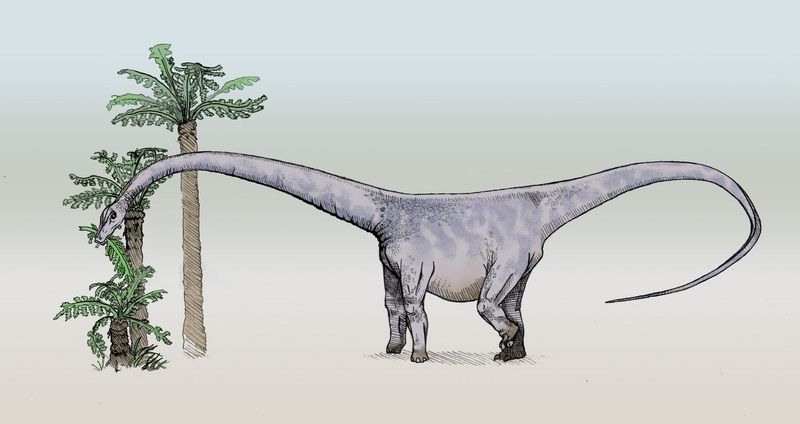Barosaurus
From Wikipedia, the free encyclopedia
Scientific classification
Kingdom: Animalia
Phylum: Chordata
Class: Sauropsida
Superorder: Dinosauria
Order: Saurischia
Suborder: Sauropodomorpha
Infraorder: Sauropoda
Family: Diplodocidae
Subfamily: Diplodocinae
[Photo] version 3 of barosaurus, by user debivort 12.06, from english wikipedia. | Permission is granted to copy, distribute and/or modify this document under the terms of the GNU Free Documentation License, Version 1.2 or any later version published by the Free Software Foundation; with no Invariant Sections, no Front-Cover Texts, and no Back-Cover Texts. A copy of the license is included in the section entitled "GNU Free Documentation License". |
Barosaurus (BAHR-oh-sawr-us) meaning 'heavy lizard' (Greek barys/βαρυ?? meaning 'heavy' and saurus/σαυρο?? meaning 'lizard', referring to its heavy neck bones) was a giant, long-tailed, long-necked, plant-eating dinosaur closely related to the more familiar Diplodocus. Remains have been found in the Morrison Formation from the Upper Jurassic Period, along with five other sauropods: Diplodocus, Apatosaurus, Camarasaurus, Brachiosaurus and Haplocanthosaurus, as well as the predator Allosaurus and armored dinosaur Stegosaurus.
Description
Barosaurus was a large but fairly typical diplodocid that lived during the Late Jurassic period, around 150 million years ago. In fact, in many respects Barosaurus was very similar to Diplodocus itself, but with slight differences: much taller backbones (vertebrae), a shorter tail, and a much longer neck. Probably more than four-fifths of this plant-eater's total length of perhaps 27 m (89 ft) was neck and tail. Presumably it had a small head, although unfortunately no specimen of its skull has been recovered, which is common in sauropods because of the small skull size.
The American Museum of Natural History in New York City has a skeleton of a mother Barosaurus rearing on her hind legs to an enormous height to protect her offspring from an Allosaurus. Her head is level with the fifth story of a building.
A very long neck
Barosaurus' was once thought to have held its head like a giraffe. In order to pump blood up to the brain ??? a height of around 12 m (39 ft), 10 m (33 ft) above the heart ??? the heart would have had to have weighed about 1.5 tonnes (3,200 lb). The larger a heart, the slower it beats. A 1.5 tonne heart would beat so slowly that the blood would run back down the neck before the next beat. To address this problem a radical theory was postulated that Barosaurus had 8 hearts ??? two in the chest and three pairs in the neck! A more reasonable alternative theory is that, like a giraffe, it had arterial valves in its neck. These operate in response to differentials in fluid pressure, allowing the blood to be pumped up the neck but preventing most of it from falling back down. More recent computer modelling of diplodocids has shown that they probably habitually held their necks more or less horizontally, thus restricting the problem to whether the animal reared up on its hind legs or not.
Although it had just 15 cervical vertebrae (neck bones), as in the shorter-necked Diplodocus, some of them were more than 1 m (39 in) long. The scoops and hollows in their structure mean that the neck as a whole was lighter than it looked.
Discovery and Species
Barosaurus lentus is one of the many sauropods discovered in North America during the "Wild West Dinosaur Hunts" (the "Bone Wars") of the late 19th century.
The remains were initially found by a Mrs E. R. Ellerman in the Black Hills of South Dakota. Othniel Charles Marsh and J. B. Hatcher collected part of the tail of the skeleton and Marsh named it in 1890. The rest of the remains were protected until Marsh sent George Wieland to collect them in 1898. Some remains of a smaller dinosaur collected at the same time were named (but not officially described) Barosaurus affinis in a paper by Marsh one month before his death in 1899.
Starting in 1922, three fairly complete B. lentus skeletons were dug out of Carnegie Quarry, Utah, by a team lead by Earl Douglas of the Carnegie Museum of Natural History, in Pittsburgh, Pennsylvania. Earlier, he had excavated Apatosaurus from the same site, and had been involved in setting up the Dinosaur National Monument there in 1915.
Late Jurassic remains from Tanzania, originally named Tornieria africana, are considered by some to be another species of Barosaurus, B. africanus, although others disagree with this and consider Tornieria a separate, valid genus. J. S. McIntosh, in 2005, noted similarities of the material with both Barosaurus and Diplodocus (possibly more with the latter) but differences as well. He concluded that further review of the material in Berlin was warranted, before it could be placed in Barosaurus.
A third barosaur species, B. gracilis, has also been identified from Africa. If B. africanus is actually T. africana, then B. gracilis is also likely to be a species of Tornieria, called T. gracilis. See the article Tornieria for further discussion.
Barosaurus species
B. lentus (type)
?B. africanus (probably Tornieria
?B. gracilis (probably Tornieria
Nomen dubium
B. affinis Marsh (1899) now considered synonymous with B. lentus.
http://en.wikipedia.org/wiki/Barosaurus
| The text in this page is based on the copyrighted Wikipedia article shown in above URL. It is used under the GNU Free Documentation License. You may redistribute it, verbatim or modified, providing that you comply with the terms of the GFDL. |
|

